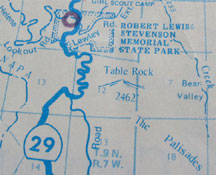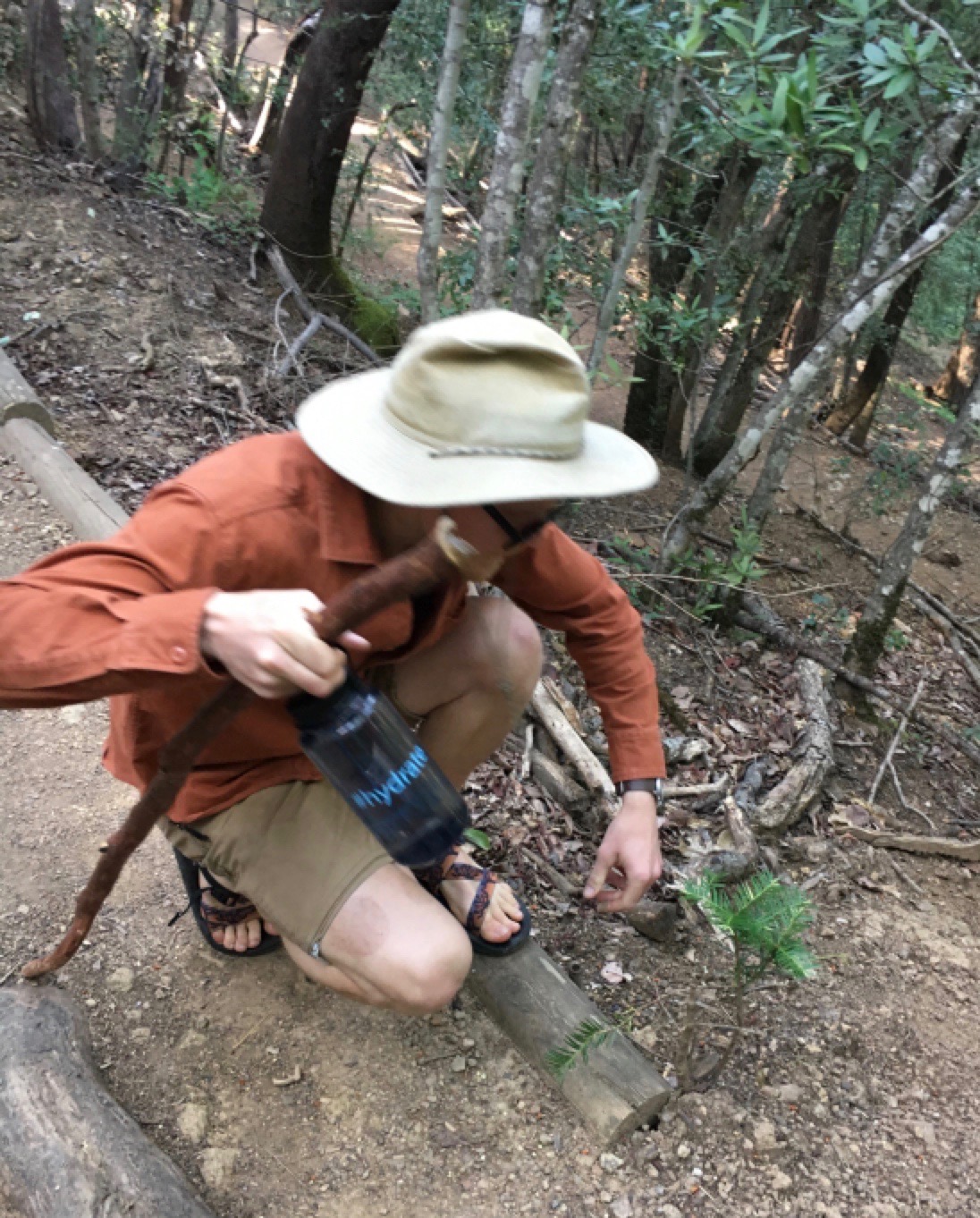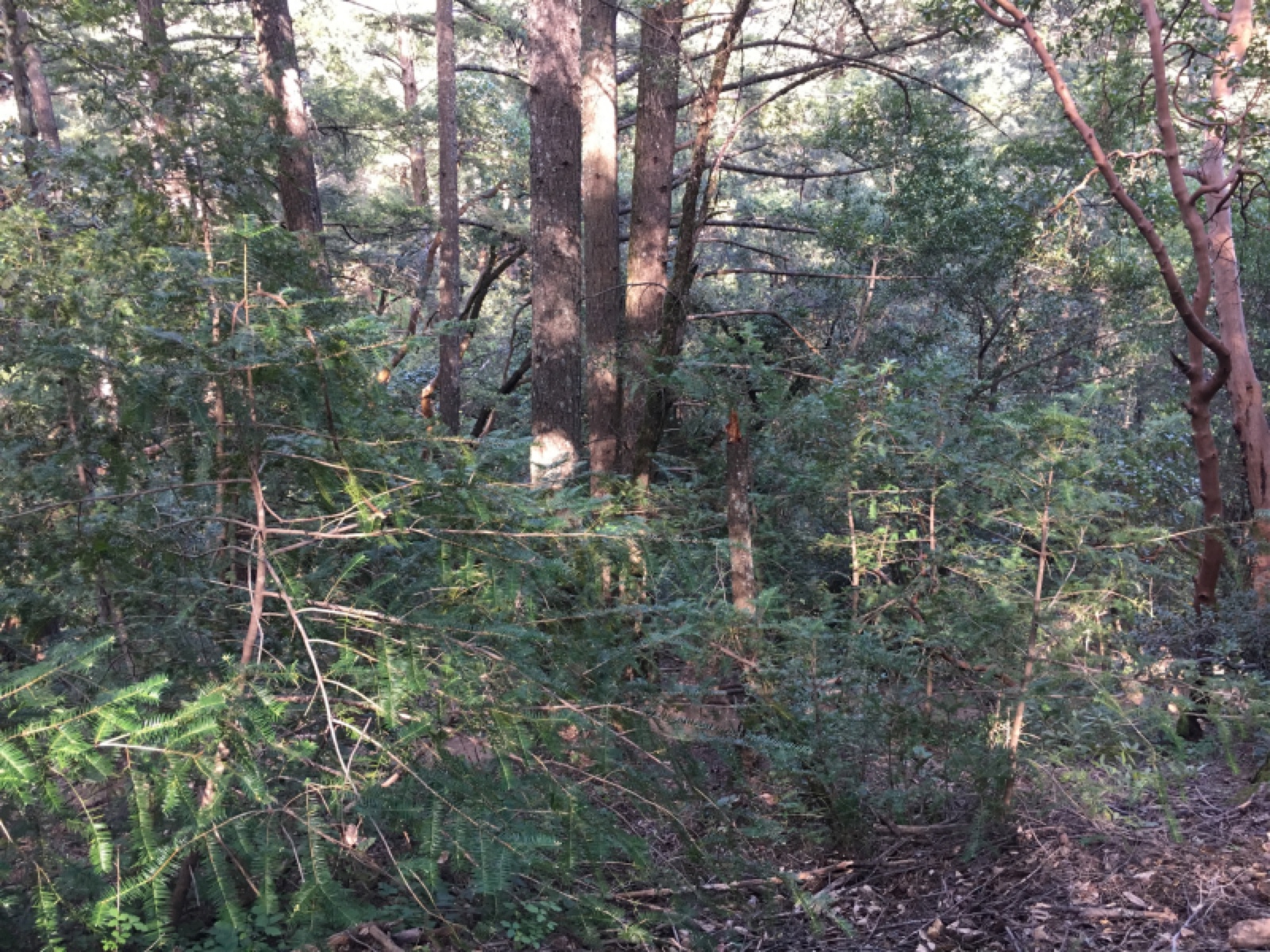in the mountains at north end of Napa Valley
approx. 2000 feet elevation
report by Connie Barlow
Robert Louis Stevenson State Park
May 31, 2005

in the mountains at north end of Napa Valley
approx. 2000 feet elevation
report by Connie Barlow
Robert Louis Stevenson State Park
May 31, 2005

LOCATION: Drive Route 29, heading north into the mountains at the north end of Napa Valley. At the road summit, which is within Robert Lewis Stevenson State Park, just before you begin the descent, you will see large gravel parking areas on both sides of the road. In the smaller, west-side parking area, you will find a signed trail that passes a picnic table and proceeds up the north-facing slope of an east-west trending ravine. Continue up this trail. Within 200 yards you will easily start spotting Torreya californica from and along the trail. Connie ran out of time, and was able to study the torreyas only along a quarter-mile of trail, so she could not delineate how far up the trail the torreya extended.Connie Barlow undertook this Torreya quest with the assistance of Napa resident Jim O'Loughlin.
1a
1b
PHOTO 1a: Jim O'Loughlin standing next to a multi-stemmed, sprawling Torreya about his height. The narrow streamlet bed of this large ravine is visible just to the right. I can't remember whether the two huge trunks are redwood or Douglas fir. (A Douglas fir cone was wedged at the base between the two largest stems of the Torreya.)PHOTO 1b: View of the base of the multi-stemmed Torreya shown in Photo 1b.
PHOTO 1c: A close view of the dead and downed stems of Torreya at the base of the multi-stemmed specimen shown in Photo 1b. 1c
1d
1e
PHOTO 1d: A downslope living branch of the same Torreya, with streamlet and boulder behind. In all of my quests for Torreya, this is the only specimen I came upon that is close to surface-flowing water.
PHOTO 1e: Lying on the ground, looking up through a Torreya branch of the Photo 1 specimen.
PHOTO 2a, 2b, 2c, 2d: This Torreya growing alongside the trail is in the size class of the largest Torreya I found on this slope. As with all of the sites I visited in California, Torreya specimens are locally abundant, although constrained in geographic extent. Of the 50 or 60 Torreya specimens I visited in this particular ravine (the only ravine I surveyed in Robert Lewis Stevenson State Park), this was the only specimen bearing FRUIT, and only 2 fruit at that! 2a
2b
2c
2d
Photo 2c (flash used for photo) is the lowest of the 2 fruit, and 2d is a view upward through this tree (a branchlet visible in foreground as silhouette). Despite the paucity of reproduction (not just fruit scarcity; I was able to locate only 1 seedling that had no close association with a living sapling), I found NO EVIDENCE OF DISEASE. I saw no yellowing of foliage, and no leaf browning or trunk cankering like that terribly evident on the few Florida Torreya specimens still alive.
PHOTO 3: A Torreya sapling finding a dabbling of light near the trunk of a large redwood or Doug fir. 3
4
PHOTO 4: This was the only dense grove of Torreya I came upon at this site. Every trunk visible in the foreground and most of the background is a Torreya.
PHOTO 5: A two-stemmed Torreya, with (difficult to see) about a dozen tiny stump sprouts at its base (visible as very light greenery there). 5
6
PHOTO 6: The end of a horizontal branch of a low, sprawling, multi-stemmed Torreya. The new growth is visible as a light green at the tips of branchlets.
PHOTO 7: A low sprawling Torreya just upslope of a madrone (left) and big Douglas fir. 7
• April 2017 UPDATE: March 24, 2017 email from Earle Cummings - "By happenstance, I visited your website and enjoyed the narrative about your California visit. We own acreage in Sonoma County north of San Francisco that is under a conservation easement with Sonoma Land Trust. Because our daughter's name is Torreya, it is a happy coincidence that we have a stand of scattered Torreya trees, mixed in among oaks, redwood and Douglasfir in one of our canyons."
• April 2019 UPDATE: On April 29, Zach St. George and his partner hiked up the same trail in the park that Barlow had explored 14 years earlier (with photos above). The PHOTOS BELOW show some of the California Torreya trees he encountered, including a set near the summit that had recently burned (likely, the Tubbs Fire of the summer of 2017). He sent 4 photos in an email to Connie Barlow, with this description:"We went hiking at Robert Louis Stevenson State Park, on the Mount St. Helena trail. About 1,000 feet from the trailhead, I noticed a California torreya, just off the trail. I didn't have my phone, so I had my girlfriend take a photo. I was pretty surprised to find it
And then, around a bend, I saw another, then another, and another. I'd only ever seen one at a time, but here I counted as many as 20 in one patch, all within a few feet of each other. I continued to see numerous torreya until maybe 600 - 750 vertical feet from the top of the mountain. Some of them bore buds [male pollen "cones"] that looked exactly like the tree I saw at Sproul Hall on UC Berkeley campus. So I'm now certain that the tree I saw on campus is a torreya.
We walked through a large area that had burned recently, I'm thinking last fall. It was a crown fire, and all of the mature trees (mostly pine) were dead. A few oaks / tanoaks survived. But I noticed a bunch of torreyas coppicing around some dead trunks. They were far bigger than the seedling pines that surrounded them, although I suspect the pines will catch up quickly.Editor's note: The coppicing (basal sprouts) are thickly growing in the 4th photo below. Notice the yellow color of the Torreya standing trunk, after its bark has fallen off. Torreya's remarkable survival capacities (the genus originated in the Jurassic) owe in part to its ability to prolifically sprout new stems from its root crown after the main stem is injured or killed. Notice how these basals are already achieving a lot of photosynthesis — which is crucial in order for the individual to keep its roots alive. Eventually, one or two of the basals will begin to rapidly grow tall, while the remaining basals continue to photosynthesize, so long as sunlight penetrates to their ground.


RETURN TO California Torreya Main Page